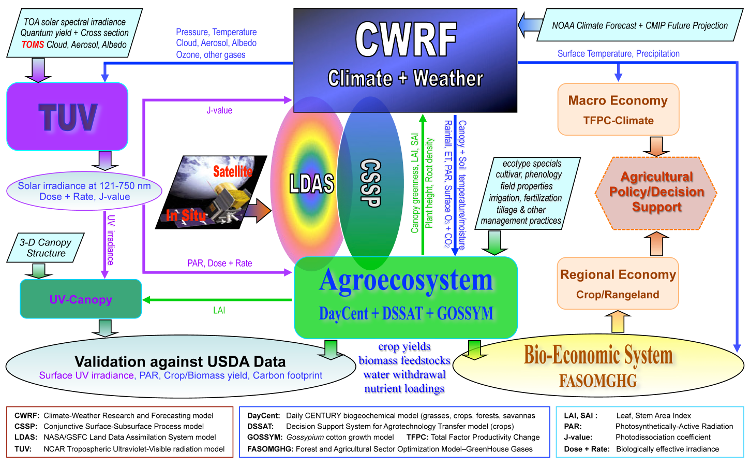The agricultural community and decision-makers need tools to reliably predict crop yields and assess optimal management practices and economic impacts under changing environmental conditions at the regional scale. To fulfill this need, UVMRP is currently developing the Climate-Agroecosystem-UV Interactions and Economic (CAIE) system with collaborators from the University of Maryland and Colorado State University. CAIE is an integrated assessment system to simulate interactions among climate, UV radiation, crop growth, and economics. Specifically, this system will be capable of predicting how the yield and quality of agricultural and economically important crops (such as cotton, corn, soybean, wheat, and rice) and rangelands respond to changes in the environment including temperature, moisture (drought), nutrients, UV-B radiation, CO2 concentration, aerosols, and other air pollutants. It will also include an economic assessment model that can predict the economic growth of agriculture crops (total factor productivity change) based on climate predictions.

Ultimately, CAIE will provide support for U.S. policymakers to not only establish necessary incentives and safety nets for producers, but also assess potential risks, determine optimal practices, design effective policies, and identify mitigation and adaptation strategies to achieve sustainable development of agriculture.
The heart of CAIE is a climate-crop model that simulates crop growth and yield based on weather, soil, and crop physiology. The model is based on a state-of-the-art Climate-Weather Research and Forecasting model (CWRF) that simulates the processes responsible for regional climate and weather at a national scale (Liang et al 2012a). It is capable of simulating terrestrial hydrology, precipitation, and solar radiation which are all critical for crop growth. CWRF also has a Conjunctive Surface-Subsurface Process model (CSSP) that simulates plant canopy properties, soil temperature/moisture distributions, terrestrial hydrology variations, and land-atmosphere exchanges of water, heat, and moment fluxes. We have coupled the climate model CWRF with the cotton growth model GOSSYM and compared the model results against reported yields (Liang et al 2012b, Liang et al 2012c). The results matched the reported yield, especially in terms of temporal and spatial patterns. In addition, GOSSYM was modified to incorporate the effect of UV-B radiation on cotton growth. The coupled model is able to simulate cotton growth and productivity under varying environmental stressors such as extreme temperature, drought, CO2, and solar UV-B radiation. UVMRP is also coupling CWRF with another crop model DSSAT-corn. Once coupled, this will be tested by retrospectively simulating crop yields over various U.S. regions with historical climate data.
UVMRP will develop a UV version of DayCent. As a well-tested model, DayCent can simulate the response of a variety of ecosystems to environmental change including grasslands of the western U.S. which receive high doses of UV-B radiation. UV-B radiation and visible light can accelerate litter decay in photodegradation processes, possibly releasing more nutrients from the litter, which are absorbed by plants or lost from the system through runoff. Our project will develop UV modules in the DayCent model to incorporate photodegradation and UV-biomass relationships. The DayCent-UV model will be calibrated and validated against the experimental data including 10-year litter decay data, and other observed ecosystem variables at multiple western U.S. sites. UVMRP will couple DayCent-UV with CWRF to examine the effects of environmental stressors including UV-B on ecosystems and study how they in turn impact climate. DayCent-UV will be modularized to be compatible with CWRF. Lastly, a method to incorporate management strategies from national inventories will be developed.
UVMRP will incorporate into CAIE an economic model FASOMGHG (Forest and Agricultural Sector Optimization Model – Green House Gasses version), which is used by EPA to simulate land allocation and the economic impacts of changing land allocation and production practices. FASOMGHG simulates the biophysical and economic processes that determine the technical, economic, and environmental implications of bioenergy production, climate change, and policy intervention. This model will be expanded to reflect municipal and energy sector demands for water, considering aquifer depth, pumping cost, wind energy, and solar power. The economic dynamics also reflect the changes in resource allocation, energy and land use at relatively longer time and spatial scales than those represented in a regional model. UVMRP will develop a feasible approach that links CWRF-CROP predicted climate and crop yield distributions at the county level to the statistical economy model of aggregate agricultural productivity at the national level. We will look for the correlation between total factor productivity change (TFPC) and key climate indices, gaining a physical understanding of their relationships. Our project will develop a multivariate regression model for TFPC and climate indices to predict total factor productivity (TFP) growth, and apply this model to regional climate changes projected by the CWRF-CROP model to predict the potential trends of future U.S. agricultural TFP. The outcome of this research will lead to an interdisciplinary approach to develop an integrated system model infrastructure (i.e., CAIE), achieving a credible and quantitative assessment of the influences of key stress factors on crop productivity, climate feedback, and economic impacts for U.S. agriculture.


